[vc_row 0=””][vc_column][vc_column_text 0=””]
After departing Seoul, I flew up north to the northerly Japanese island of Hokkaidō. My goal is to sample numerous onsen (hot springs) and do some hiking, traveling by train and bus. Many of our family have visited Japan, or at least have heard much about it, so it seems a bit unnecessary to go into detail. Yet the experience of going to rural Japan made a big impression on me the last time we came, so I’ll try to bring the experience to life for those who have not been there.
Japan has over 3,000 natural hot springs (onsen), and I plan to visit a number of the best outdoor versions. Judy and I traveled two times in Japan, and I came to love the Japanese tradition of communal bathing in very hot (up to 108°F) natural thermal water (no chlorine). It can be a shock at first to get into water this hot, but when you get out, you are limp and relaxed. Ah!
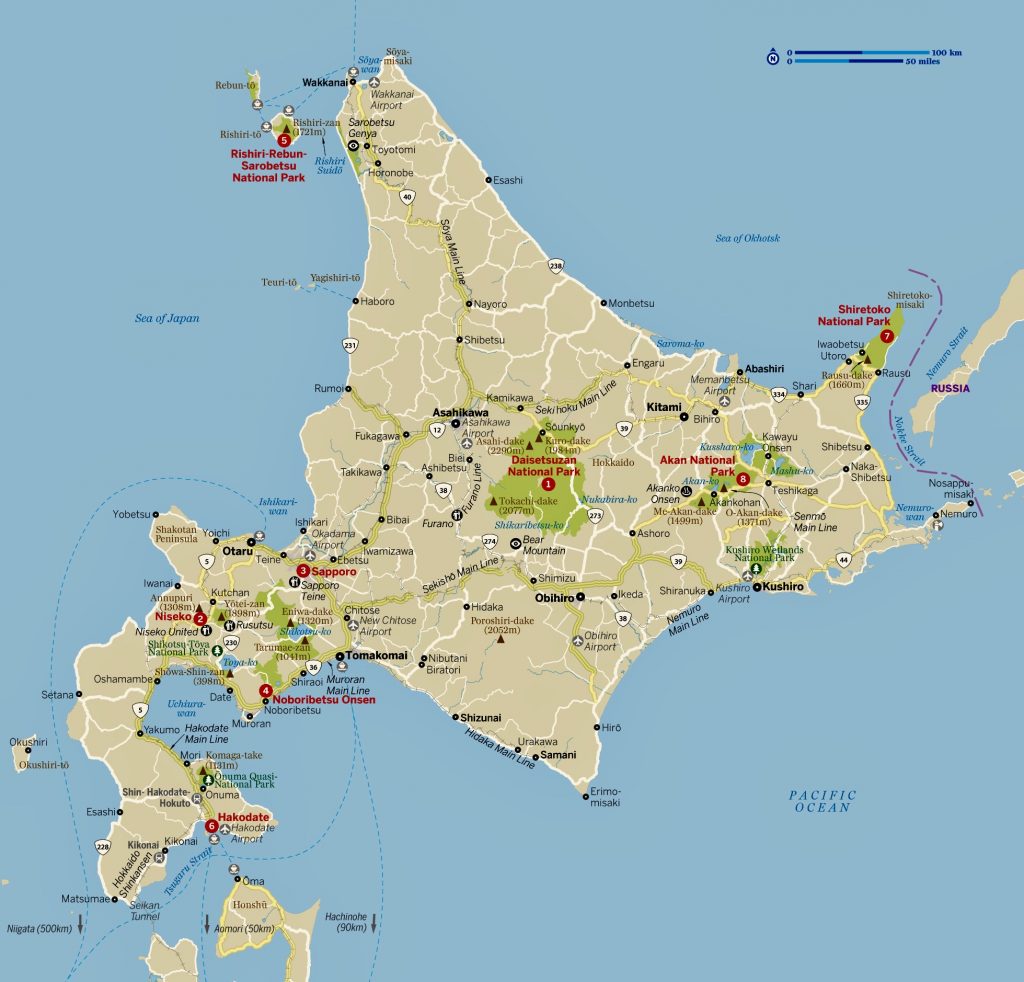
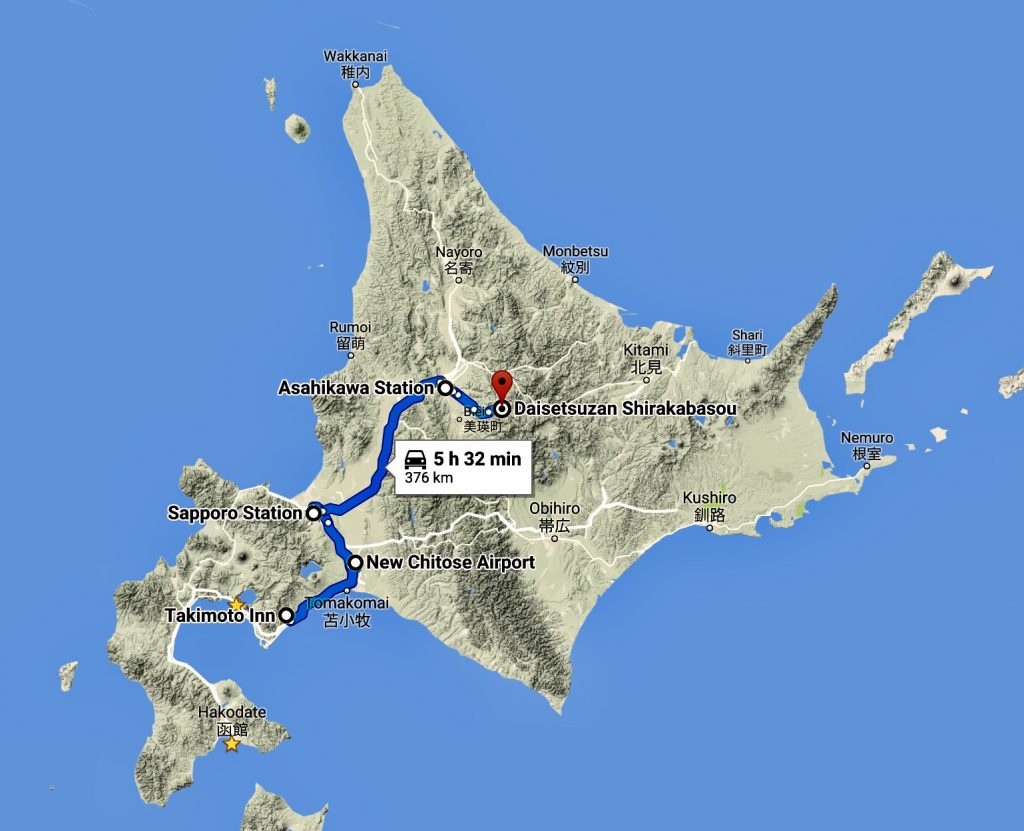
Daisetsuzan National Park (“Big Snow Mountain”) has the highest mountain in Hokkaidō, and when I get there on October 1st, there may already be the first snow of the season.
I began my trip at New Chitose Airport (CTS), about 45 km south of Sapporo. Coming in late evening, I opted to stay at the Airport Terminal Hotel.
Having your phone able to use the internet is essential! It allows you to look up transit on Google Map, and to use your phone as a ‘personal hotspot’ for your laptop. It saves you time and money. I have an ‘unlocked’ phone, and get a local SIM for data only wherever I go.
My first onsen is Noboribetsu. Ah, it is so good to arrive in rural Japan in the cooling weather of early autumn, and soak in an outdoor hot springs!
[/vc_column_text][/vc_column][/vc_row][vc_row 0=””][vc_column 0=””][vc_masonry_media_grid grid_id=”vc_gid:1506925408971-49e9baaa1495861d349c2fa69c069ea7-4″ include=”7525,7527,7528,7521,7522,7523,7519,7524,7518,7517,7530,7529″][/vc_column][/vc_row][vc_row 0=””][vc_column][vc_column_text 0=””]
The onsen tradition is almost ceremonial. You leave your shoes on a rack, put your valuables in a little locker and your clothes in an open basket. You take a little hand towel with you into a pre-wash area. You sit on a little stool along a row of hand showers with shampoo and body soap, and thoroughly wash yourself (you must be sparkling clean before entering the common bath).

You then walk through the many bath areas, with your little hand towel draped in front of your crotch (or not, it seems optional) and get in the pool of your choice. Some are hotter than others, and my favorites are outdoors. Even the ceremony of the onsen is soothing.

You can stand under a 4 cm stream of pleasantly hot water dropping from 4 meters up, which gives the effect of a hydraulic massage as it pounds down on you. It’s like standing under a hot waterfall!
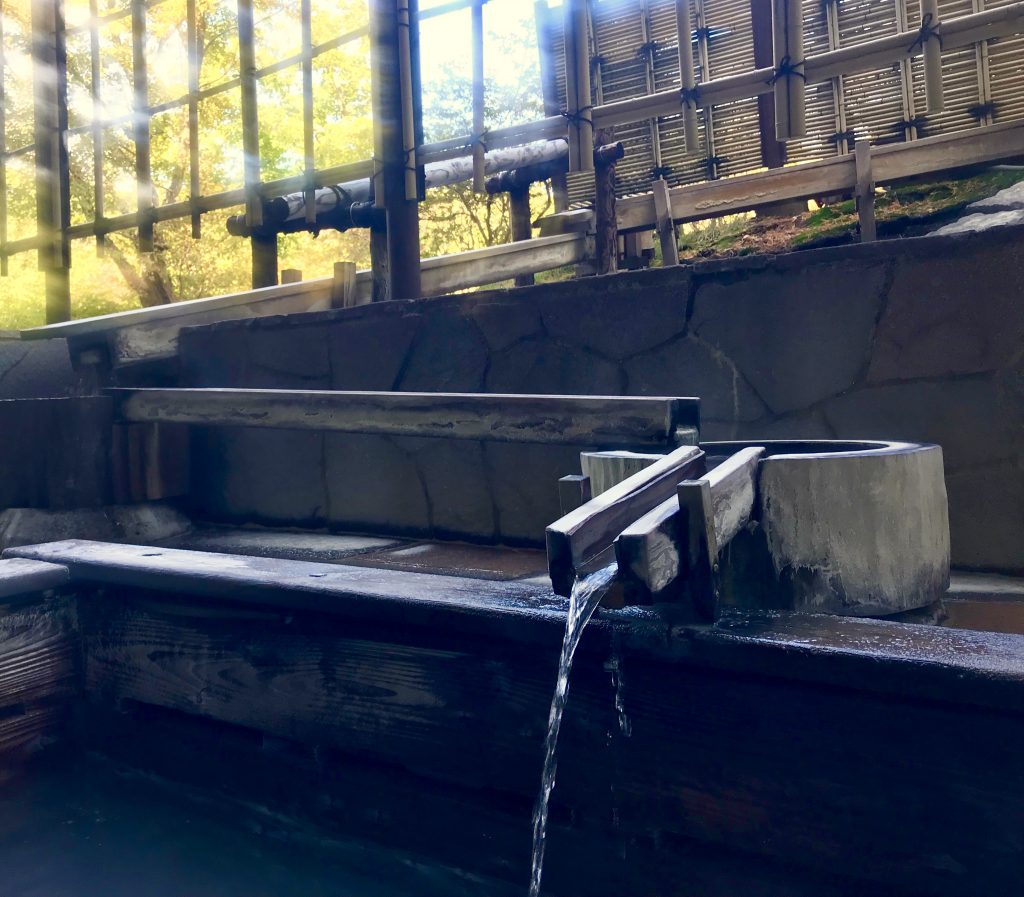
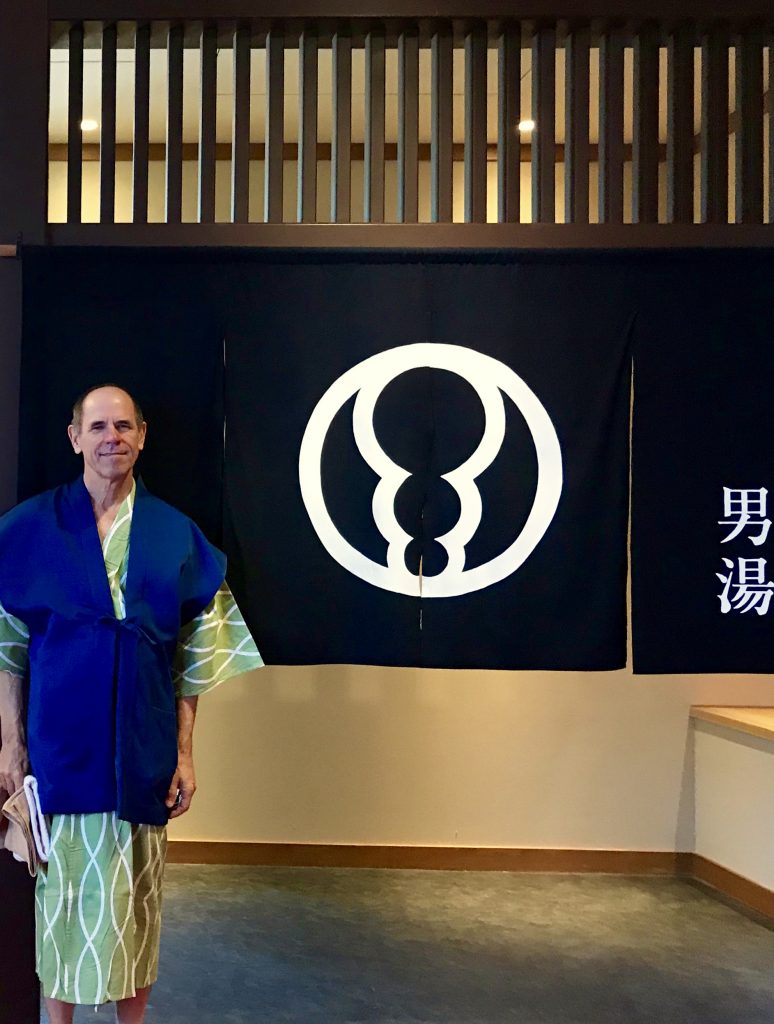
Each room has a robe like this. You are free to wander around town in them in an Onsen area. Most relaxing.
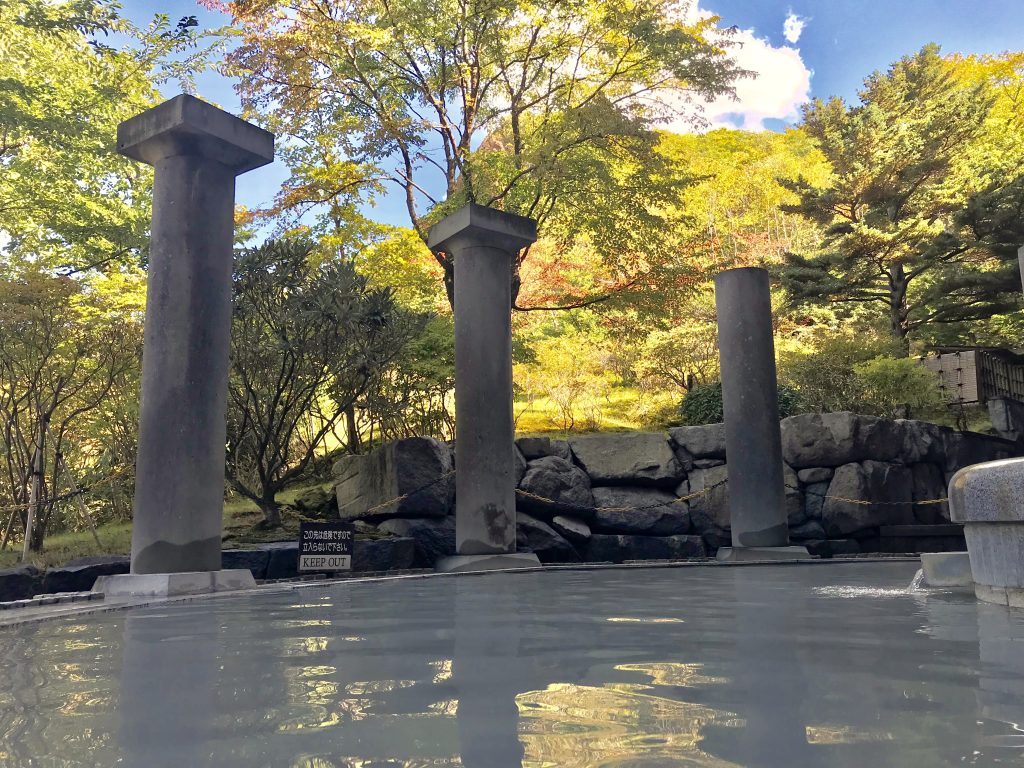
The water has so many minerals dissolved in it that it is grey, like the streams running off glaciers.
Sitting in the outdoor pool at Onsen Tengoku (“Onsen Heaven”), you look out at the hillside, beginning to turn bright fall colors. A cool breeze refreshes you, as many crows circle overhead above the hillside. You can see steam rising up the valley. There is a low murmur of Japanese talk around you. A gust of wind sweeps through, and little leaves swirl around and drift into the pool. You sometimes catch a whiff of sulphur in the air. At night, you see many stars. It is easy to calm the mind and just soak in the natural beauty.
Buddha was sitting in a natural hot springs in Japan, meditating, and it came to him: “THIS is nirvana!”
Just kidding. I made that up, but there is a grain of truth in it. Limp rags sleep well. This is going to be a fun trip!
(One fly in the ointment: Asian beds. The common preference in Asia is for very firm beds, as in ‘like sleeping on a carpeted floor’. This addresses Buddha’s warning about sleeping in ‘high, comfortable beds’)
Hell Valley, Noboribetsu Onsen, Hokkaidō, Japan from Mel Malinowski on Vimeo.
On a 4 km hike up the valley, there is a ‘Natural Foodbath’ where a small stream of about 40°C water runs, and you can sit and soak your feet. Ah!
40°C = 104°F. 37C is body temperature. 30°C = 86°F. 20°C = 68°F. 0°C = 32°F. 1°C = 1.8°F. I’m going to spend this year in metric.

[/vc_column_text][/vc_column][/vc_row][vc_row 0=””][vc_column 0=””][vc_masonry_media_grid grid_id=”vc_gid:1506925409029-b3cb934642f681aee888bd3548201a1f-6″ include=”7543,7542,7541,7544,7545,7546,7551,7552,7554,7556,7555,7557,7553″][/vc_column][/vc_row][vc_row 0=””][vc_column][vc_column_text 0=””]
Noboribetsu Onsen was fun, and a great start to my Japanese journey. Today I moved on, taking a bus to Sapporo, 1 ¾ hours, then train 1 ½ hours to Asahikawa, then bus 1 ½ hours to Asahidake Onsen.
I’m staying at Daisetsuzan Shirakabasou there, a JYH (Japan Youth Hostels) with dorms and some private rooms with a small indoor and outdoor hot spring. I am in a traditional Japanese tatami mat room, sleeping on a futon. There is a soft scent of tatami mat in the room, from the rice straw they are woven from. Dinner was ample and delicious. The indoor onsen is about 39°C, and the outdoor one only 37°C, about body temperature. I prefer warmer.

[/vc_column_text][/vc_column][/vc_row][vc_row 0=””][vc_column 0=””][vc_masonry_media_grid grid_id=”vc_gid:1506925409099-947ee40b44ed6f2cb96b060c2037ede5-7″ include=”7591,7579,7592,7595,7593,7581,7578,7576,7575,7577,7582,7594″][/vc_column][/vc_row][vc_row 0=””][vc_column][vc_column_text 0=””]
Tomorrow, I will hike to the top of Mount Asahi, the highest mountain in Hokkaidō. It’s not so high, but it snowed there two days ago, qnd there is snow on top. Does the name ‘Asahi’ ring a bell? After studying how to brew lager beer in Germany, an enterprising local fellow brewed the first beer in Japan in Sapporo in 1876.
Well, the weather was NOT favorable! But I hiked anyway. Wind so strong it nearly knocked me over a couple of times up on the ridge, with wind chill of about -5°C. I had to go to max face coverup before heading back down into the blast of the wind. It was good exercise, though, and the onsen warmed me back up.
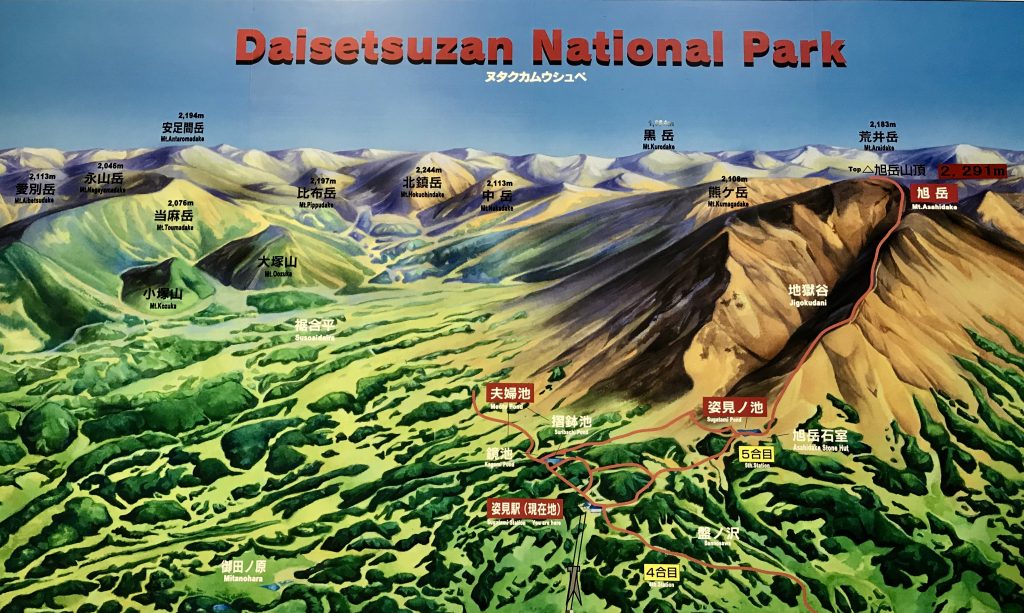
[/vc_column_text][/vc_column][/vc_row][vc_row 0=””][vc_column 0=””][vc_masonry_media_grid grid_id=”vc_gid:1506925409180-e4b201c2532fdaf1023e7df21761a436-6″ include=”7580,7583,7588,7587,7586,7589,7584,7585″][/vc_column][/vc_row][vc_row 0=””][vc_column][vc_column_text 0=””]
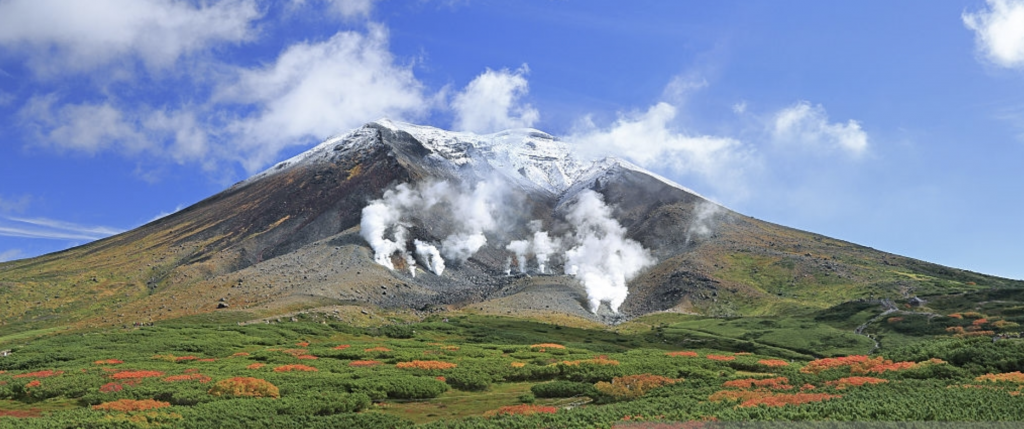
What I might have seen, if the skies had cleared. Mount Asahi.
I talked at dinner with a couple living in Seattle, who are veteran long-distance hikers, getting ready for the Annapurna Circuit later in October. We shared helpful apps. They like maps.me, which gives you offline-usable maps internationally. I like it. Two other useful apps, each with pluses and minuses, are AllTrails, and Wikiloc. For just tracking, MotionXGPS is useful, too. Google Maps is helpful in cities, but not much for trails, nor some countries abroad. I have come to regard carrying a GPS device on the trail as essential, and some smart phones are nearly as good as the Garmin dedicated devices, and lighter.
Next morning, it was colder, and I could see that the cloud level was down at around 500 feet above ground level. The forecast was for snow, so I decided to not go up high. Good decision—those who did tried hiking to the summit of Mount Asahi, got blasted by sleet, and turned back.
Instead, I hiked cross-country to an interesting outdoor onsen one canyon over. Such a pretty hike! It wound up a 17 km. plus 1400 meters of up/down, a full day of hiking. I took time in the middle for udon noodles for lunch and a soak in the 40°C outdoor onsen at Tenninkyo Onsen. Ah!
[vc_row][vc_column][vc_masonry_media_grid grid_id=”vc_gid:1507031338043-2d44626d-5164-7″ include=”7616,7609,7610,7611,7612,7613,7614,7615,7617,7625,7624,7622,7623,7621,7618,7619,7620″][/vc_column][/vc_row]
I awoke on my last day to see snow falling outside. Very pretty! Asahidake Onsen is at the same latitude as Eugene, Oregon, where it is certainly not snowing on October 4th.
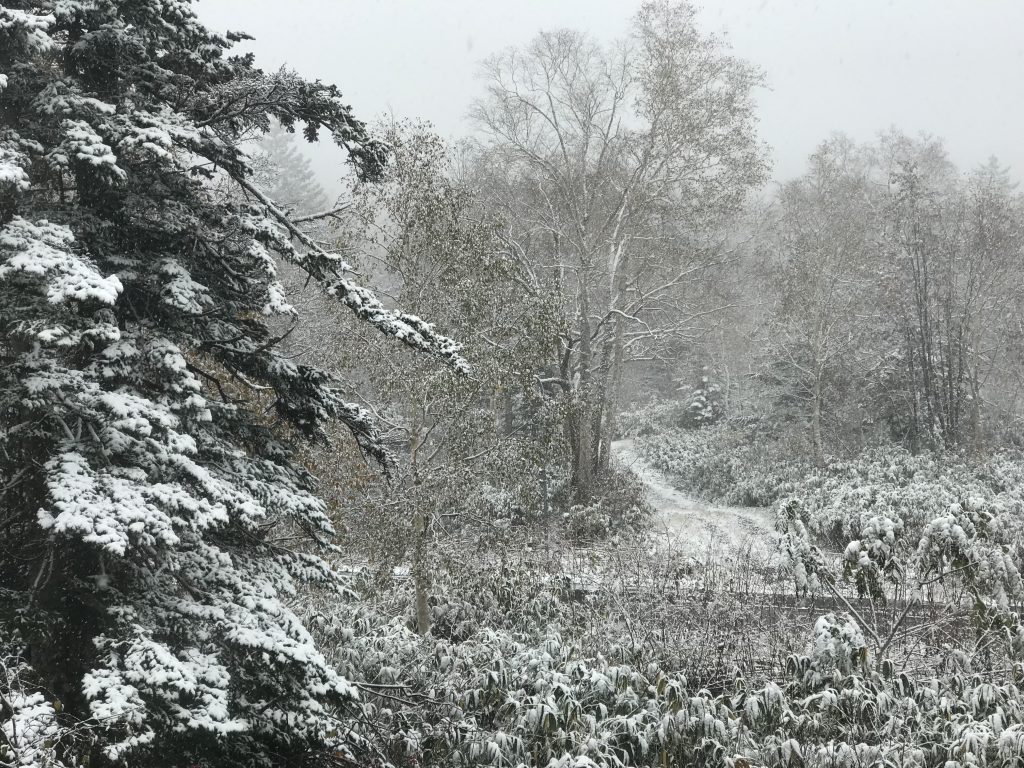



Indoor Onsen at my hotel in Asahikawa. Onsen are typically called ‘public baths’. Blue seems to be the color code for the men’s bath, red for women.It would be most awkward to walk into the wrong entrance!
Time to head down to Asahikawa for a day, then on to Sapporo.

Rice, part of the heart and soul of Japan.
Sapporo receives 6 meters of snow a winter (over 19 feet). Skiing is a school subject studied by almost all children. One elementary school even has its own ski jump on campus. Each winter, there is a Sapporo Snow Festival with ice and snow sculptures.


I had the good fortune of being here during a Van Gogh exhibition. I had not realized how much Japanese use of color & line influenced Van Gogh. Seeing his canvases again up close reminds me of how well he used thick texture of the paint with bold brush strokes. This doesn’t really come across in 2D reproductions.
[vc_row][vc_column][vc_masonry_media_grid grid_id=”vc_gid:1507362033034-7348c49a-d24b-0″ include=”7680,7678,7679,7681,7677,7673,7671,7668,7669,7670,7674,7667,7666,7665,7664,7660,7663,7658,7662,7661,7659,7657,7655,7654,7653,7650,7649,7648,7656,7652,7651″][/vc_column][/vc_row]
A lovely chilly fall morning in Sapporo. I can tell already that 6 weeks will only be enough to see a fraction of Japan.
Speaking of fractions: there is a HUGE underground network of passages in Sapporo that keep things moving in the long, snowy winters. Underground shops, food, everything! I wish I could be here for the Sapporo Snow Festival.
[vc_row][vc_column][vc_masonry_media_grid grid_id=”vc_gid:1507461933172-73fc477a-14c6-5″ include=”7693,7692,7695,7694,7696,7698,7699,7700,7701,7705,7702,7703,7704,7706,7697,7674,7675,7676″][/vc_column][/vc_rowū
Time to head south to Honshū Island.

Leave a Reply
You must be logged in to post a comment.